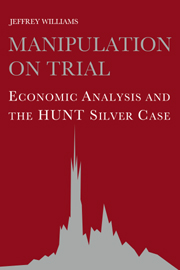Book contents
- Frontmatter
- Contents
- List of figures
- List of tables
- Preface
- Foreword by Thomas O. Gorman
- 1 Why the Hunt silver case?
- 2 Turmoil in the silver market
- 3 Identifying a manipulation
- 4 Testing for the cause of the price rise in silver
- 5 Determining the appropriate price of silver
- 6 Inferring manipulative intent
- 7 The predicament of economic analysis in the courtroom
- Glossary of commodity market terms
- References
- Index
6 - Inferring manipulative intent
Published online by Cambridge University Press: 17 September 2009
- Frontmatter
- Contents
- List of figures
- List of tables
- Preface
- Foreword by Thomas O. Gorman
- 1 Why the Hunt silver case?
- 2 Turmoil in the silver market
- 3 Identifying a manipulation
- 4 Testing for the cause of the price rise in silver
- 5 Determining the appropriate price of silver
- 6 Inferring manipulative intent
- 7 The predicament of economic analysis in the courtroom
- Glossary of commodity market terms
- References
- Index
Summary
The Hunts' involvement with the silver market in 1979 and early 1980 was incessant. They hardly spent a day without taking delivery on some futures contract, without adjusting the composition of their positions through rollovers into other delivery months, without negotiating some exchange for physicals, without communicating with CBOT and Comex officials. At the time and in the subsequent legal proceedings, the Hunts were credited with an overarching rationale for their actions. From that quite natural supposition arose an inductive logic: some of the Hunts' actions could betray the purpose of all their actions, whether the purpose be investment, as the Hunts maintained, or manipulation, as the plaintiff charged. The intention behind the Hunts' actions was paramount because under the relevant statutes as they have come to be interpreted, no wrongdoing ensues without the specific intent to manipulate.
The CFTC Division of Enforcement characterized a number of the Hunts' particular transactions as “manipulative acts.” In like manner, Minpeco compiled a list of “uneconomic acts” committed by the Hunts, which supposedly were unprofitable by themselves but furthered a manipulative scheme as a whole. According to the defense, many of these actions had innocent interpretations or were economically rational. It instead pointed to other actions consistent with the objectives of long-term investment as indicating the Hunts' motives. Despite disagreement over the purposes of particular acts, all the lawyers and economists concerned accepted that detailed analysis of specific transactions could reveal intent.
Information
- Type
- Chapter
- Information
- Manipulation on TrialEconomic Analysis and the Hunt Silver Case, pp. 161 - 189Publisher: Cambridge University PressPrint publication year: 1995
